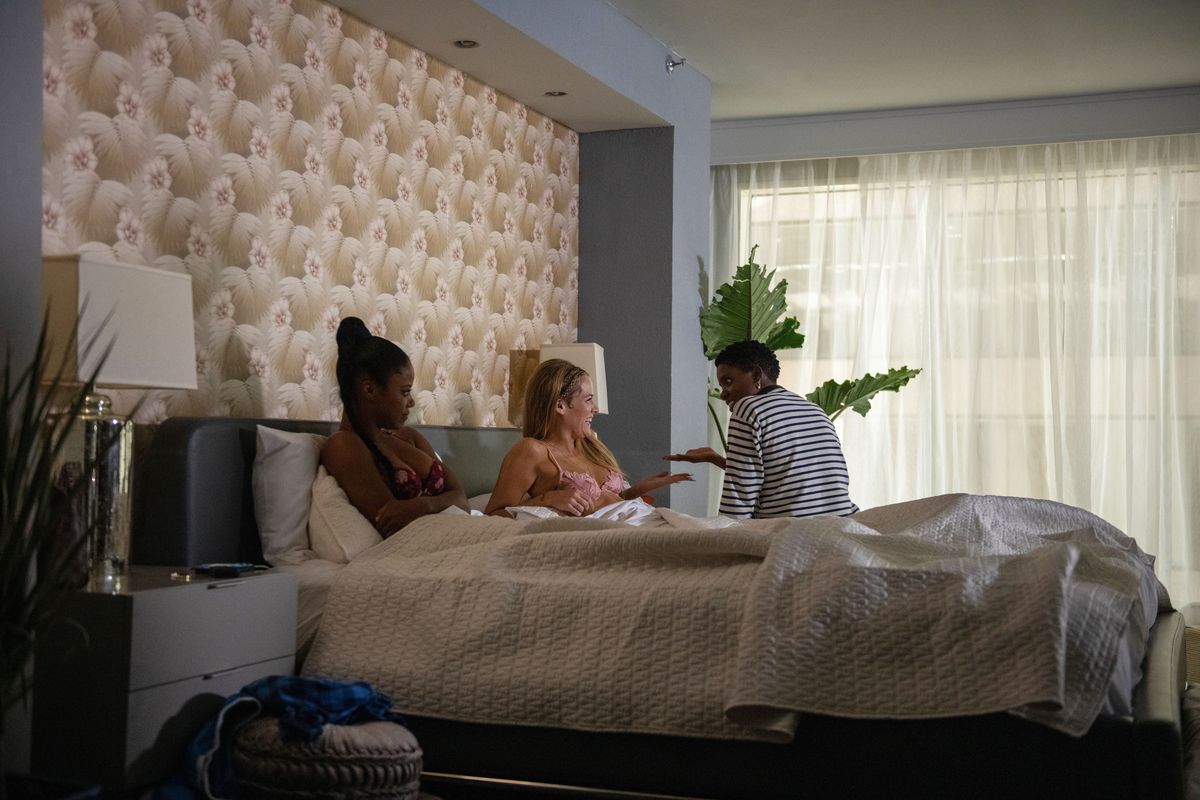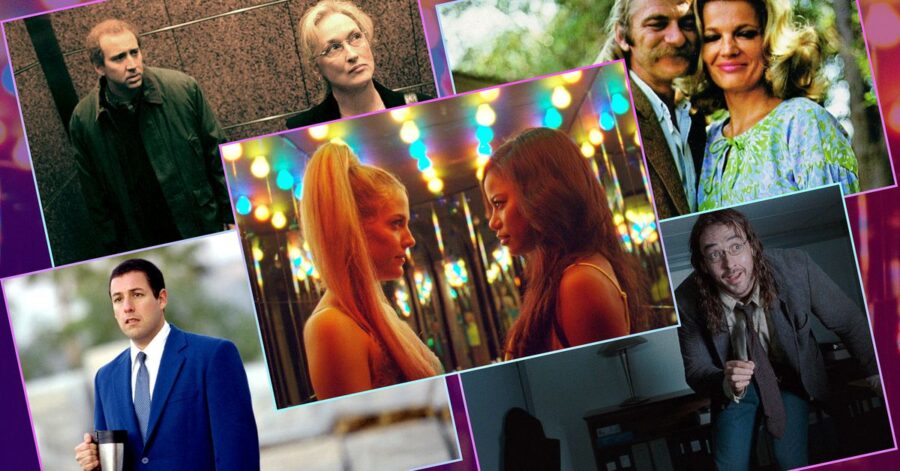Zola, out on Wednesday, is one of the most anticipated and visually idiosyncratic films to come out in 2024. Starring Taylour Paige (Ma Rainey’s Black Bottom) and Riley Keough (Under The Silver Lake), the new A24 film transforms Aziah “Zola” King’s raucous 2015 Twitter account of a weekend trip stripping in Florida gone terribly wrong (a thread recently published as a book) into an odyssey worthy of Homer. As Matt Patches put in Polygon’s review out of the 2019 Sundance Film Festival, “So many filmmakers come to mind when the credits roll on Zola: Joel and Ethan Coen, Paul Thomas Anderson, Andrea Arnold, Martin Scorsese, and even Hollywood Shuffle director Robert Townsend — people known for synthesizing image and script, comedy and thrills, the personal and universal. Zola works at that level, with Bravo’s vision empowering Paige’s observant-but-active lead performance.”
With Zola releasing in theaters this Wednesday, Polygon chatted with director Janicza Bravo (Lemon, FX’s Atlanta) about what makes for a successful “stressful comedy,” the process of developing the film’s distinctive visual style and callbacks to 2015-era social media, and the type of films she would program for a film festival dedicated to Zola.
[Ed. note: This interview has been edited for concision and clarity.]
In an interview with Hollywood Reporter, you said the genre of “stressful comedy” as the one you feel the most comfortable working in. What are some of your favorite stressful comedies, and what in your opinion distinguishes those kinds of movies apart from regular comedies, in your words?
I refer to my own work as stressful comedy. And I think that lane means it’s work that is very funny, but also very uncomfortable. And sometimes it’s just not funny at all — it’s just uncomfortable. So I’m like somewhere in that sweet spot. Some of my favorite stressful comedies, I would say Minnie and Moskowitz is probably my number one; [John] Cassavetes’ movie starring Gena Rowlands and Seymour Cassel. It’s just a beautiful love story, if you have Criterion Channel it’s on there right now. Another one I really dig would be something more modern, Punch Drunk Love. I think Charlie Kaufman’s work actually also kind of exists in this sphere, like Being John Malkovich. [And] Adaptation! I feel like those films all would kind of fit in that space.
While filming the movie, were there any other films you looked to for inspiration that draw similar inspiration from the interactive aesthetic of social media?
I think this is gonna sound bad, but I don’t want it to sound bad. I don’t think that there is a movie that is talking to the internet like I am in this film. Or is speaking to like the aesthetics of the digital world like I am. There are plenty of digital gestures in the movie that I haven’t seen used before. I haven’t seen a timestamp in a film; I haven’t seen a screensaver in a film; I haven’t seen the lock screen used in the way that the timestamp is; I haven’t seen texting used as monologue and sort of treated like a Shakespearean aside. And maybe they do exist, I just haven’t seen that movie.
Cell phones are so much a part of our life, and so when you’re dealing in modern work, it’s natural for characters to text or talk on their phones. And I just thought it just felt so miserable watching someone stare at a phone, right? Or watching some text on a phone and then the text is on screen, or watching someone text on the phone and then you’re showing like a image of their phone. We’ve already seen that, and I think maybe the beginning of seeing that has kind of worn off and so now it starts to feel a little bit exhausting. I thought so much about how to engage these things that are so embedded into our life? How to engage them differently or in a way that I hadn’t seen that still excited me.

I was trying to treat 2015 a little bit like it was a period. Like, to me, we’ve made a period film. 2015 is a time capsule. It feels archival. I mean gosh, wasn’t that just so long ago? [laughs] There are these certain things that were introduced to us by way of our cell phones that are now just very much a part of our life, and so I was also trying to call attention to what our relationship were to a certain visual things. Like how they’ve now become embedded. We have sort of a Pavlovian relationship even to the sound cues of social media. There’s a volume button later in the film, there used to be a larger one that was more period specific, but the volume button in the movie resembles more how it looked in 2016 or 2017. The one we were using initially was taken from the 2015 image, which was kind of like a like a triangle of sorts. I ended up getting rid of it because at one of the first screenings, when it came on screen, a lot of people in the audience went to their phones. And I think that our brains are just fucked. Our relationship to our phones is fucked. The other thing that happens too is that there’s a Twitter whistle throughout the movie, and sometimes I’ve noticed people go to silence their phones whenever they hear that. Which to me, I think that’s awesome. I love that. I think that’s fantastic.
How did you conceptualize the social media affordances of the film? Were there any sort of direct reference materials you were pulling from, like videos that you or the cast shot? How did you go about visualizing and implementing that in the film?
A lot of those things are scripted. I’m trying to think like what specifically, I mean, so many things were also like post. Like, the scroll is something that happened in post. We had a visual effects specialist who came in and built that for us. So that’s not something that happened in the moment. Even that in-screen screenshot of them driving down the road, a lot of that magic happened later. There’s a scene when Riley’s taking a photo of both her and Taylour and you see the moment where the flash goes, or where the camera shutters because there are those blackouts inside of it; like that’s what happens when you take a picture on the phone. That’s what happens and so we’re replicating that. So a lot of that stuff was in post, but it was written into the dialog. There’s a line that says that’s going to happen, but we kind of had to imagine that it would, because like, in the scene, we’re just living and that kind of became a part of our magic later. That was our sauce that came later.

You’ve spoken before about how you knew you were the best person to tell Zola’s story and, in essence, to protect her character. That you are afraid that if you weren’t to do it, that there might have been a version of this movie where Zola would not have been given a fair shot. Tell me more about that.
I think we’re both living in the same world. And in the world that we’re living in, Black women are not afforded dignity or often room. There is a version of this movie that treats that character like she is disposable; treats her world like it is disposable; treats her agency like it’s insignificant. I felt I was the right person for it because I was going to protect it; I was going to protect it through and through and was sort of down for the long haul. I am forever in community and in union with the real Zola. I think when regular people — and the word “regular” sounds kind of odd — but I think when we engage people outside of this business, real people, and we invite them into this business, I do think there is responsibility to take care of them, and to guide them and to make sure that they’re going to be treated right. Because this business, like a multitude of creative businesses, profits off of the backs of many without crediting them. And when confronted with that fact many will just turn around and say well, they signed on the dotted line! So I just didn’t want us to do that. I wanted us to be able to be an example of maybe how to do it right. I don’t know that we did everything right, but I know we did some things right.
Let’s imagine for a sec that there’s an entire film festival dedicated to Zola. “Janicza Bravo presents: The Zola Festival.” What are some of your favorite movies that you would love to see play alongside Zola, or ones whose themes, tone, and look you feel compliment those of your own film?
I think that if we were going to do say, a night or a day of a festival that was inspired by Zola, I would want to play a series of Pam Grier films: Coffy, Cleopatra Jones, Foxy Brown, Jackie Brown. I feel like that when I started to work on the movie and I started to work on that character, I asked myself and my co-writer Jeremy O. Harris, “Can you name a black female protagonist who you’ve seen in a lead? Who seems almost like a superhero; Who’s totally fearless, but is also quite feminine and comfortable in her sexuality?” And we both found ourselves gravitating towards Pam Grier and that being sort of like, the first and the last time we had really seen that so clearly. So I would definitely program a series of Pam Grier films around Zola.
Zola will be released in theaters on July 30.
Polygon – All
Source link
Related Post:
- Alfred Hitchcock Vertigo is an adventure inspired by classic Hitchcock movies, out later this year
- Reminder: Knockout City Season 2 Out Now, Adds Free Movies-Inspired Map and More
- 5 great movies that inspired Green Knight on Disney Plus, HBO Max, and Amazon
- Quick Beats: Celeste Composer Lena Raine On Her Love For Ghibli, Hurdy-Gurdies, And Her Cat
- Netflix reveals the top 10 most-watched original movies to date
- Rainbow Six Siege Reveals Operation Crystal Guard, Osa, Her Gadget, and More
- Battlefield 2042 datamine reveals Tarkov and Hunt: Showdown-inspired Hazard Zone
- Death Stranding Director’s Cut Should Not be Called “Director’s Cut” – Hideo Kojima
- Don’t Call Death Stranding Director’s Cut A Director’s Cut, According To Hideo Kojima
- New Ghost Of Tsushima Director’s Cut Trailer Reveals More About Iki Island
